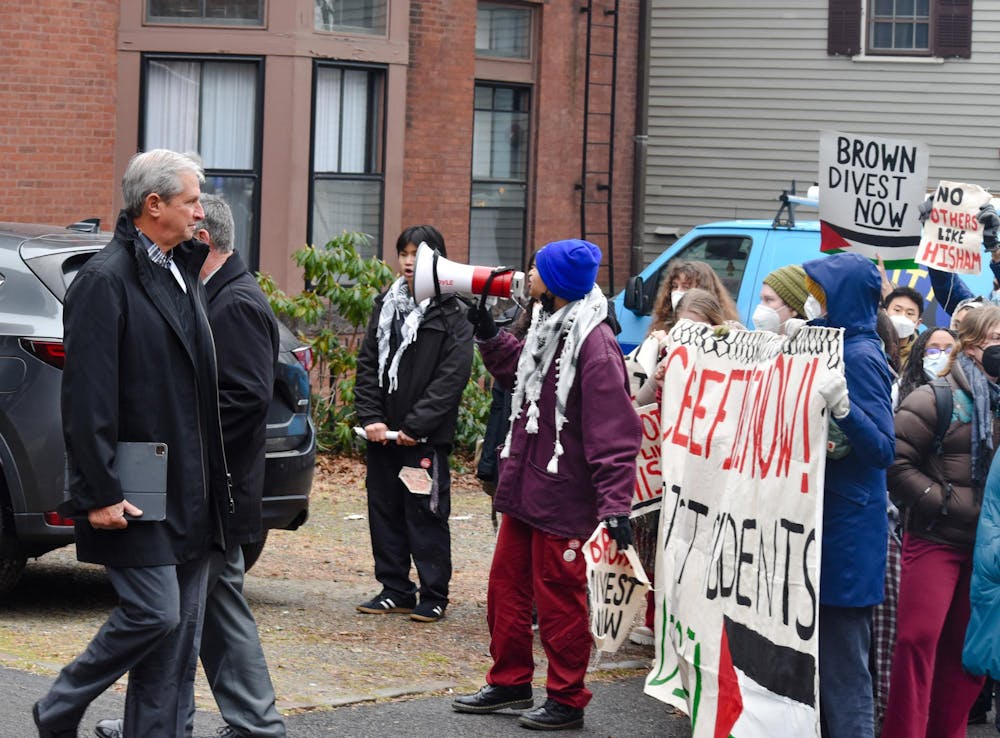At 8 a.m. Friday, a group of around 150 protesting students — including the 17 students currently participating in a hunger strike — surrounded the Faculty Club building on Benevolent Street to urge the Corporation — the University’s highest governing body — to hear the Brown Divestment Coalition’s divestment proposal.
Demonstrators handed out copies of BDC’s “critical edition” of the 2020 Advisory Committee on Corporate Responsibility in Investment Practices, which recommended the University divest from “companies which profit from human rights abuses in Palestine.” At least five University officials were seen with copies of the report. Corporation members were present on campus for their thrice-yearly meetings, with the first taking place in February.
This Friday marked the seventh full day of the strike. Over 100 students at Pomona College, the University of Chicago, Indiana University, Mount Holyoke College, Yale and Harvard have organized solidarity strikes in support of the strikers at Brown, according to a UChicago United for Palestine Instagram post.
Many of the students protesting are also participating in a 32-hour “solidarity fast” of around 200 people, according to strike organizers.
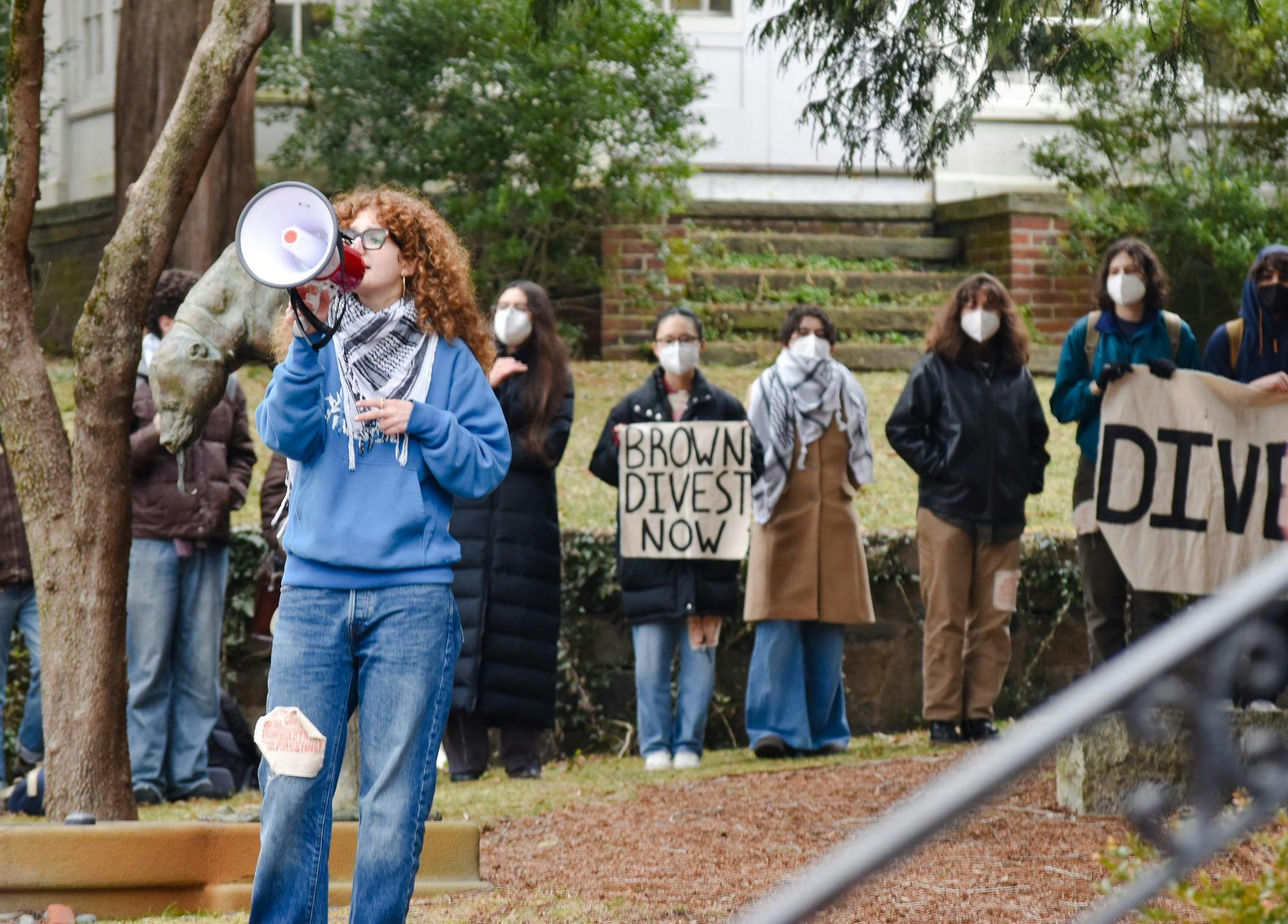
At 9:25 a.m., roughly 20 University officials left the building and walked down the street to the Hope Club. The protesters followed them and began to chant outside the building, holding up copies of the BDC report.
Some officials took copies of the extended report handed out by protesters. Not all officials present were Corporation members.
Strikers suspected that the Corporation held a breakfast at the Faculty Club “based on a combination of precedent — this is where and when (Corporation) breakfasts are usually held — and the presence of DPS at the faculty club even prior to our arrival,” Strike Spokesperson Sam Stewart ’24 told The Herald.
The locations and timings of Corporation meetings are not publicly available, according to Senior Vice President for Communications Cass Cliatt. The Corporation began its meetings on Thursday and historically concludes on the weekend, according to past letters from President Christina Paxson P’19 P’MD’20.
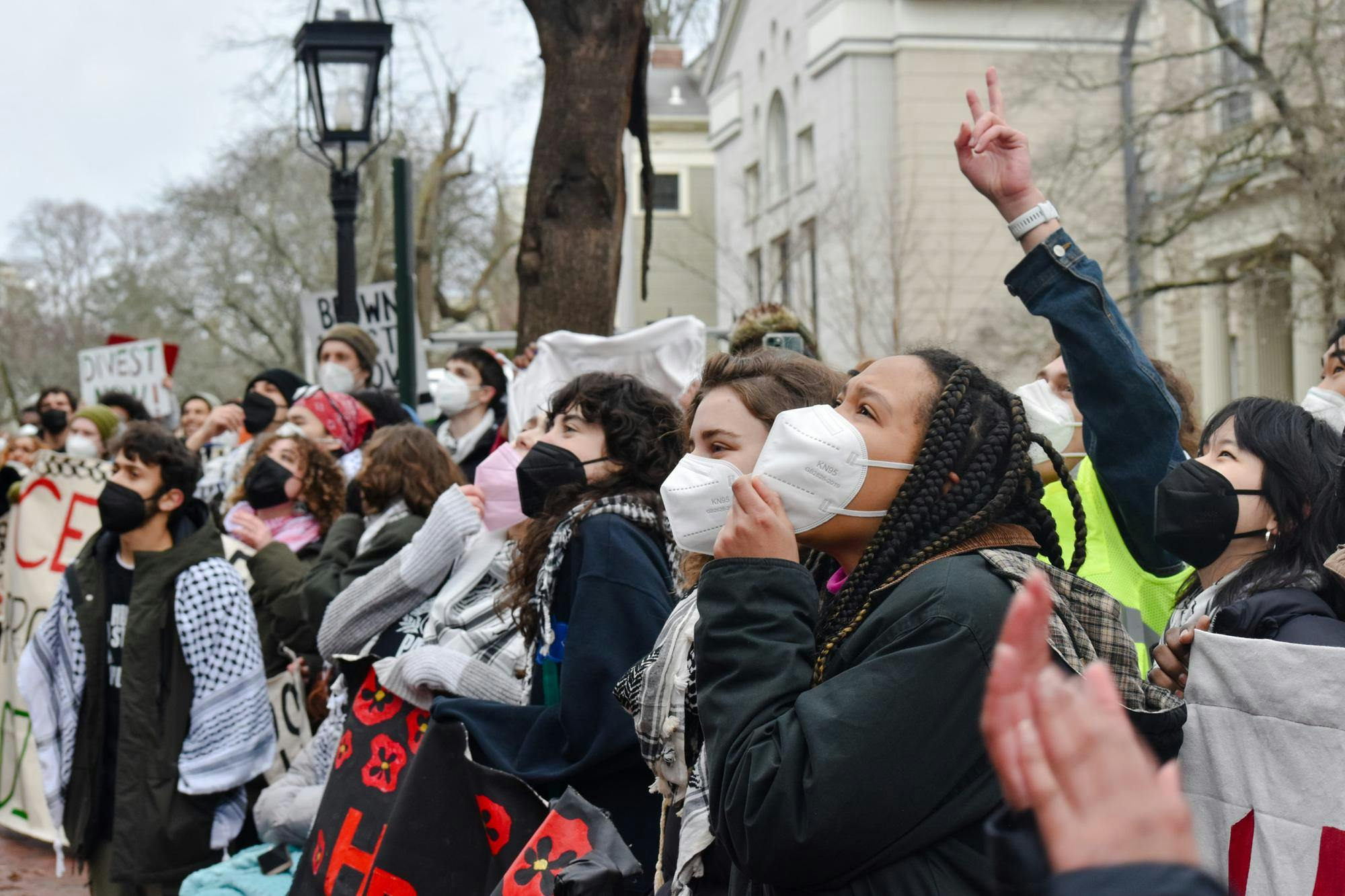
At last year’s February Corporation Meeting, about 20 members of Students for Justice and Palestine and the Graduate Labor Organization protested in support of divestment, where students distributed fliers and spoke with Corporation members, The Herald previously reported.
Corporation agendas are not disclosed prior to the meeting, but “actions taken by the Corporation” are communicated to the Brown community, Cliatt previously told The Herald.
At 10:39 a.m., Corporation members left the Hope Club and boarded Brown University shuttles labeled “special” and “charter.” Corporation members were then seen at the Watson Institute for International and Public Affairs, where they continued their meetings.
At 10:55 a.m., groups of protesters converged at Watson, surrounding the building from both west and east entrances and waiting for Corporation members to leave the building. Around 15 protesters — including several of the hunger strikers — stood inside the building at the entrance to the Joukowsky Forum, where Corporation members held their meeting. Two Department of Public Safety officers were present at the meeting’s entrance.
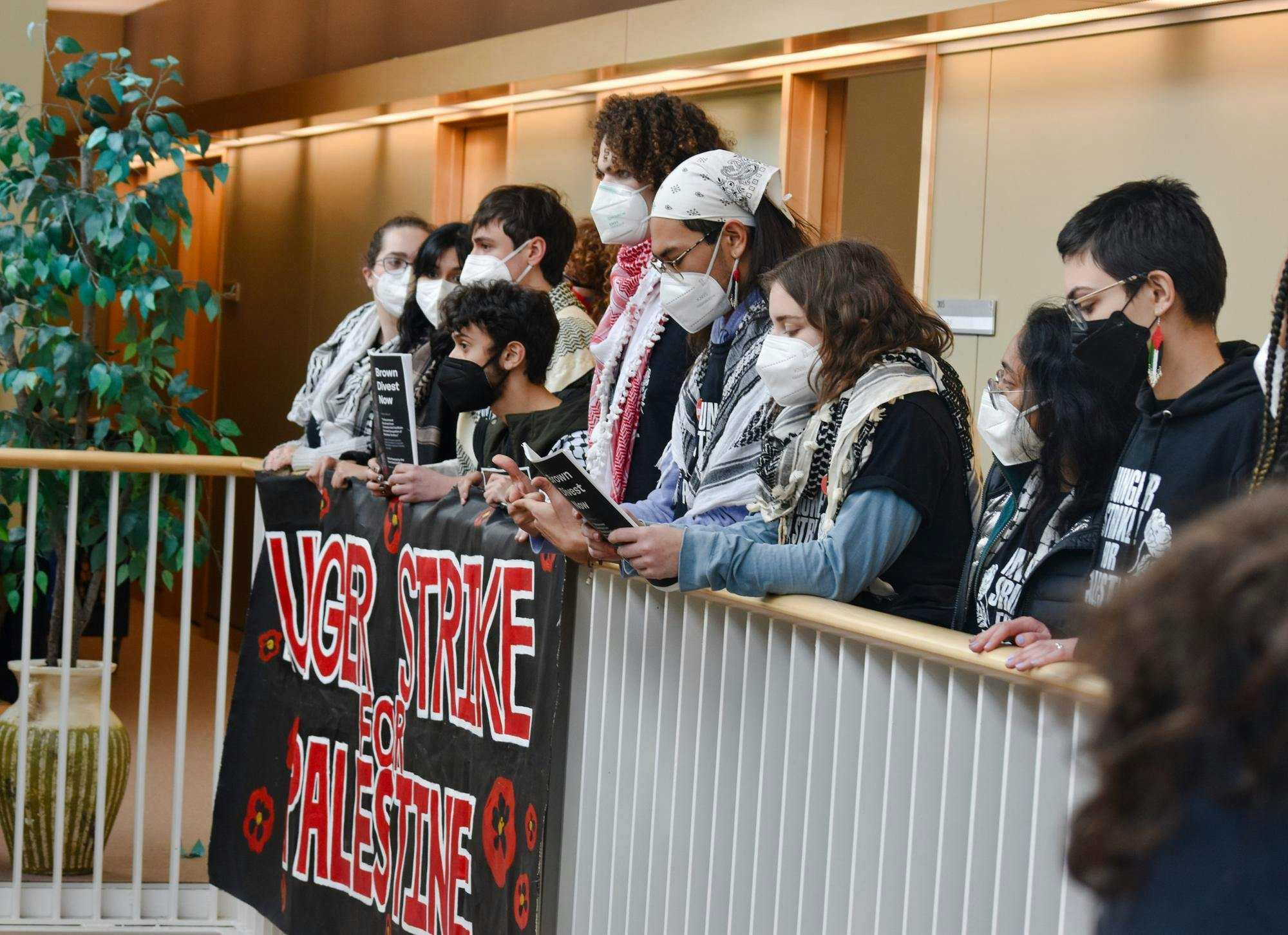
The University’s Protest and Demonstration Policy states that “protests or demonstrations that infringe upon the rights of others to peaceful assembly, orderly protest, free exchange of ideas, or that interfere with the rights of others to make use of or enjoy the facilities or attend the functions of the University cannot be tolerated.”
At 12:07, Corporation members left the Joukowsky Forum for a catered lunch hosted in the McKinney Conference Room on the third floor of 111 Thayer St, which houses the Watson Institute. Several University deans and high-ranking officials were in attendance — at least five were seen carrying BDC’s critical edition of the ACCRIP report. Paxson also joined the group’s lunch.
Protesters outside gathered around the McKinney Conference Room’s glass windows, chanting “enjoy your lunch” and “it’s day eight” at the lunch attendees.
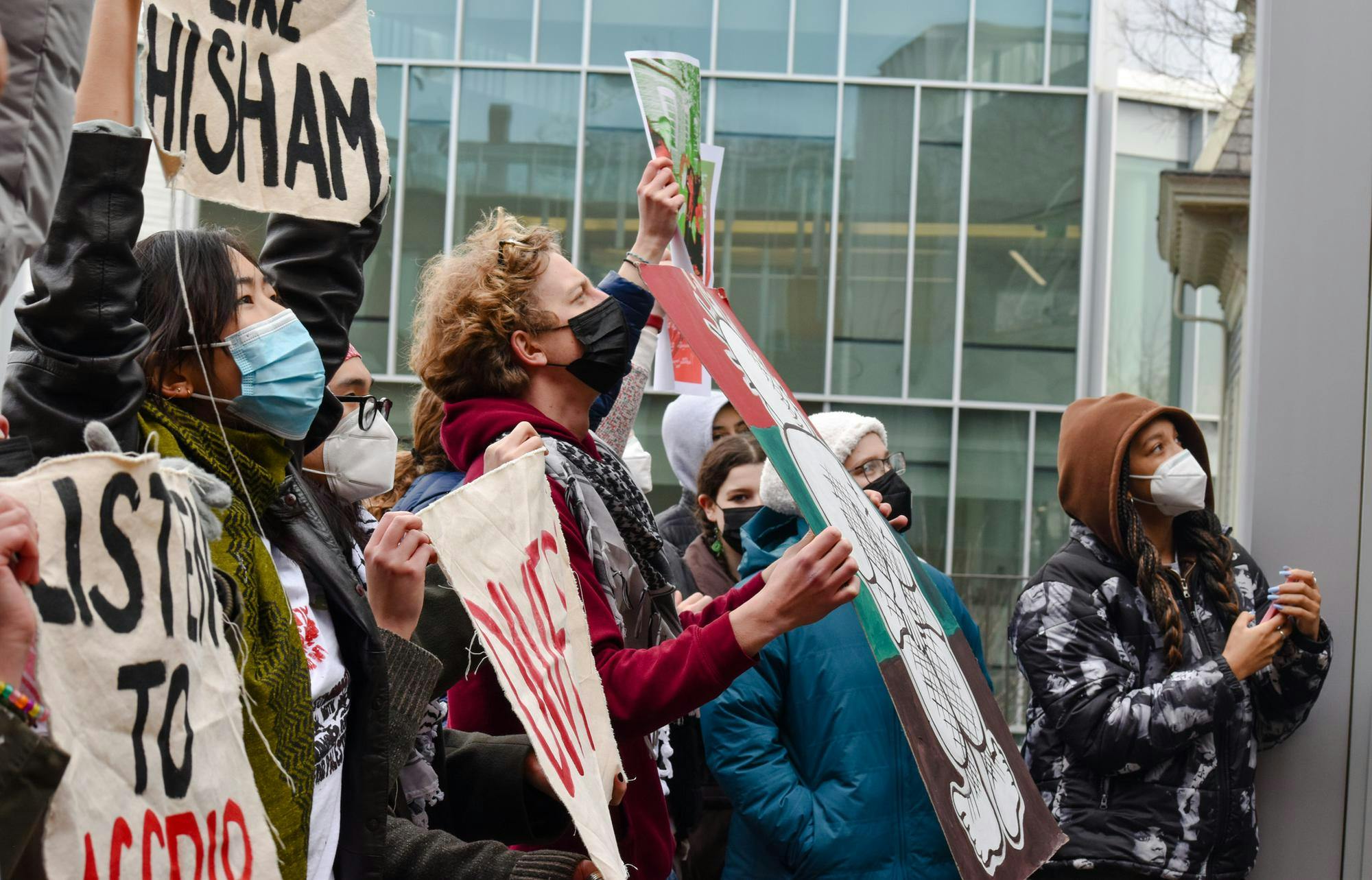
At 12:28 p.m., protesters inside 111 Thayer St. moved up to the third floor of the building, holding up banners that read “Ceasefire Now! Protect Students! Divest!” and “Hunger Strike for Palestine” against the railing across from the McKinney Conference Room. Students also held copies of the BDC report.
Two DPS officers — badge numbers 207 and 236 — stood at the threshold of the Corporation luncheon. They told The Herald they do not know when they will finish.
Beginning at 1 p.m., protesters from outside moved into the building, lining the walls of the building’s second and third floors, hanging banners and holding signs in silent protest.
Corporation members left the lunch at 1:50 p.m., walking past the strikers and solidarity protesters. Two students repeatedly addressed the officials as they departed but received no response.
“We are on day eight of the hunger strike,” strikers said. “Will you listen to our demands so we can start eating again?”
Officials began to leave the building at 2:08 p.m. Approximately 15 Corporation members boarded a Brown University Shuttle to an unknown location. As they walked to the shuttles, no members of the Corporation commented on whether they discussed the divestment resolution when asked by The Herald.
Students then filed out of Watson into Starr Plaza after officials and Corporation members had left the building.
“To students around us who are watching us, please follow us and follow those … in the previous student movements against apartheid and against genocide and act up,” Eli Grossman ’25, a protester at the rally, said. “Make sure that your corporations are not invested in the deaths and dehumanization of Palestinians.”
At 5:00 p.m., the 17 strikers ended their week-long refusal of food and around 200 students ended their solidarity fast. Read The Herald’s coverage of the strike’s end here.
Editor’s Note: Below is a summary of previous coverage by The Herald detailing common questions about the strike and related University policies.
What did the students demand?
The 17 student protestors refused food until the Corporation — the University’s highest governing body — “hears and considers a divestment proposal” during its meetings that began Thursday. The strikers say the proposal should be consistent with the 2020 report by the University’s Advisory Committee on Corporate Responsibility in Investment Practices that recommended divestment from “companies which profit from human rights abuses in Palestine.”
Paxson previously refused to bring ACCRIP’s recommendations to the Corporation for consideration, saying that the report “did not meet established standards” for divestment. On Friday, she maintained this position and refused to revisit her decision. She also denied the protestors’ request for a Corporation divestment resolution.
Instead, she encouraged the protestors to submit a divestment proposal to the Advisory Committee on University Resource Management — the successor to ACCRIP — instead of demanding a Corporation resolution.
The protestors have refused this referral to ACURM, saying that the length of time required to consider this proposal in the committee is “an untenable timeline given the urgency of the crisis in Gaza,” according to a statement from strike organizers to The Herald.
Past demonstrators, including the 41 students who were arrested during a December sit-in on trespassing charges, were previously referred to ACURM when they demanded divestment from “Israeli military occupation.”
What investments does the University hold?
At a November public meeting, representatives from the University’s Investment Office told attendees that Brown’s direct investments do not include weapons manufacturing or those with direct ties to Israel.
University Spokesperson Brian Clark echoed this statement in a Sunday email, writing that Brown is “not directly invested in any defense stocks or large munitions manufacturers.”
A large portion of the University’s endowment is invested in external managers with portfolios that are undisclosed under contractual confidentiality provisions. At the November meeting, the Investment Office said none of these portfolios focus on weapons manufacturing and they select “managers whose values are aligned with the Brown community.”
Clark also wrote on Sunday that the University is “confident that our external managers have the highest level of ethics and share the values of the Brown community, including the rejection of violence.”
The University has only passed two full, official divestment resolutions in the past.
What health safeguards did the strikers have in place?
The protestors were cleared to participate in the strike by individual consultation with physicians prior to the demonstration, The Herald previously reported.
“All strikers have been testing for COVID daily and constantly wearing high quality masks, as has anyone who has interacted with them,” Stewart wrote.
According to Stewart, “there are thorough contingency plans in place in case of an emergency” as they continue “monitoring vitals regularly to ensure we are up to date on striker health.”
In a Feb. 2 letter to the protestors, Paxson encouraged the students to “safeguard (their) health and well-being” while exercising their “right to protest.” She also highlighted University mental health and well-being resources.
She added that “protest is also unacceptable if it creates a substantial threat to personal safety of any member of the community.”
The University previously disenrolled four students participating in a hunger strike protesting the University’s partial divestment policy of South African apartheid in the 1980s. The then-administration cited health and liability concerns for the disenrollment, according to a 1986 article by The Herald.
Editor’s note: A previous version of this article stated that 18 students remained on hunger strike. A spokesperson for the strikers stated today that an additional striker had dropped out on earlier this week, bringing the total number of remaining strikers to 17 at time of publication. The Herald has edited its recent coverage to reflect the update.

Anisha Kumar is the senior editor of community and standards of The Herald's 135th editorial board. She previously served as a section editor covering University Hall and international student life. She is a junior from Menlo Park, California concentrating in English and Political Science who loves speed-crosswording and rewatching sitcoms.

Ryan Doherty is the managing editor of digital content and vice president of The Herald's 135th editorial board. He is a junior from Carmel, NY who is concentrating in chemistry and economics. He previously served as a university news and science & research editor, covering faculty and higher education.

Tom Li is the editor-in-chief and president of The Herald's 135th editorial board. He is from Pleasanton, California and studies economics and international and public affairs. He previously served as a metro editor, covering the Health & Environment and Development & Infrastructure beats, and has worked on The Herald's copy editing, editorial page board, design and podcast teams.
Dana Richie is a senior staff writer for Arts and Culture and the photo chief. She enjoys using multiple forms of media to capture peoples’ stories and quirks. In her free time, she loves knitting, learning about local history and playing ultimate frisbee.

